key KIA Rio 2005 2.G User Guide
[x] Cancel search | Manufacturer: KIA, Model Year: 2005, Model line: Rio, Model: KIA Rio 2005 2.GPages: 238, PDF Size: 2.6 MB
Page 65 of 238

3-55
Trunk Lid (For 4 Door Coupe) To open the trunk, insert the key into the lock and
turn it clockwise until an audible “click” is heard.
To close the trunk, use both hands to push the trunk
lid down until the lock “snaps’’ shut.
Do not slam the trunk lid.
Pull up on the trunk lid to make sure it is securely
latched.
To prevent premature wear or damage to the trunk lid
lift cylinders and attaching hardware, the trunk lid
must be fully closed before you drive your vehicle.
1B3104007E
Unlock
Key slot
If you must drive with the trunk lid open, keep the air
vents open so that additional outside air comes into the
vehicle.Remote Trunk Lid Release (If Equipped)The release is located at the left front corner of the dri-
ver’s seat on the floor. To open the trunk, pull up on
the lever.
WARNING -Exhaust Fumes
If you drive with the trunk lid open, you will
draw dangerous exhaust fumes into your vehi-
cle.
1B3104004C
RIO ENG CNA 3.qxd 7/29/05 5:13 PM Page 55
Page 83 of 238

Ignition SwitchIgnition Switch and Anti-Theft Steering
Column LockIgnition Switch Position
LOCK
The steering wheel is locked to protect against theft.
The ignition key can be removed only in the LOCK
position. For vehicles equipped with an automatic
transaxle, it also locks the gear shift lever in the
P (Park) position.
ACC (Accessory)
Turning the ignition switch to this position unlocks the
steering wheel and will allow some of your vehicle’s
electrical accessories such as the radio to operate when
the engine is OFF.
ON
Turning the ignition switch to this position allows you
to test your vehicle’s warning lights (except the brake
system warning light) to make sure they work before
you start the engine. The ignition key returns to the
ON position once the engine is started and remains in
this position while the engine is running.
Do not leave the ignition switch in the ON position for
extended periods with the engine OFF because the bat-
tery will discharge.
Driving Your Vehicle4-2
AS2B04001
✽
NOTICE
This spark ignition system meets all require-
ment of the Canadian interference - Causing
Equipment Regulations.
RIO ENG CNA 4.qxd 7/29/05 5:06 PM Page 2
Page 84 of 238
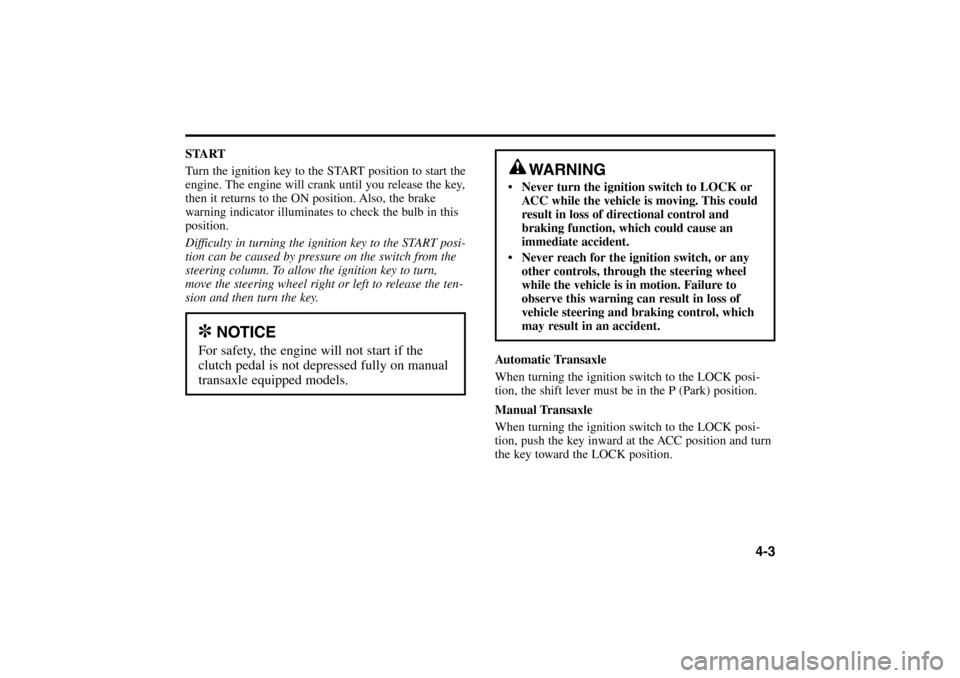
START
Turn the ignition key to the START position to start the
engine. The engine will crank until you release the key,
then it returns to the ON position. Also, the brake
warning indicator illuminates to check the bulb in this
position.
Difficulty in turning the ignition key to the START posi-
tion can be caused by pressure on the switch from the
steering column. To allow the ignition key to turn,
move the steering wheel right or left to release the ten-
sion and then turn the key.
Automatic Transaxle
When turning the ignition switch to the LOCK posi-
tion, the shift lever must be in the P (Park) position.
Manual Transaxle
When turning the ignition switch to the LOCK posi-
tion, push the key inward at the ACC position and turn
the key toward the LOCK position.
4-3
WARNING
• Never turn the ignition switch to LOCK or
ACC while the vehicle is moving. This could
result in loss of directional control and
braking function, which could cause an
immediate accident.
Never reach for the ignition switch, or any
other controls, through the steering wheel
while the vehicle is in motion. Failure to
observe this warning can result in loss of
vehicle steering and braking control, which
may result in an accident.
✽
NOTICE
For safety, the engine will not start if the
clutch pedal is not depressed fully on manual
transaxle equipped models.
RIO ENG CNA 4.qxd 7/29/05 5:06 PM Page 3
Page 85 of 238

Starting the Engine1. Make sure the parking brake is applied.
2.Manual Transaxle- Depress the clutch pedal fully
and shift the transaxle into NEUTRAL. Keep the
clutch pedal depressed while cranking the engine.
The starter will not operate if the clutch pedal is not
fully depressed.
Automatic Transaxle- Place the transaxle shift
lever in P (Park). Depress the brake pedal fully.
You can also start the engine if the shift lever is in
the N (Neutral) position.
3. Turn the ignition switch to START and hold it there
until the engine starts (a maximum of 10 seconds),
then release the key.
In extremely cold weather, below minus 18°C (0°F), or
after the vehicle has not been operated for several
days, let it warm up without depressing the accelerator.
Whether the engine is cold or warm, it should be start-
ed without depressing the accelerator.If the engine fails to start using this procedure, attempt
the following.
The engine fails to start when the engine is cold
(engine coolant temperature is below 32°F/0°C):
A no start condition may be caused by an engine that
has become flooded (has excessive fuel in the cylin-
ders). If this is the case, follow the starting procedure
below.
1. Make sure the parking brake is applied.Driving Your Vehicle4-4
✽
NOTICE
If the engine stalls while you are in motion,
do not attempt to move the shift lever to P
(Park).
If it is safe to do so considering traffic and
road conditions, you may put the shift lever
in the N (Neutral) position while still moving
and turn the ignition switch to the START
position in an attempt to restart the engine.
RIO ENG CNA 4.qxd 7/29/05 5:06 PM Page 4
Page 86 of 238
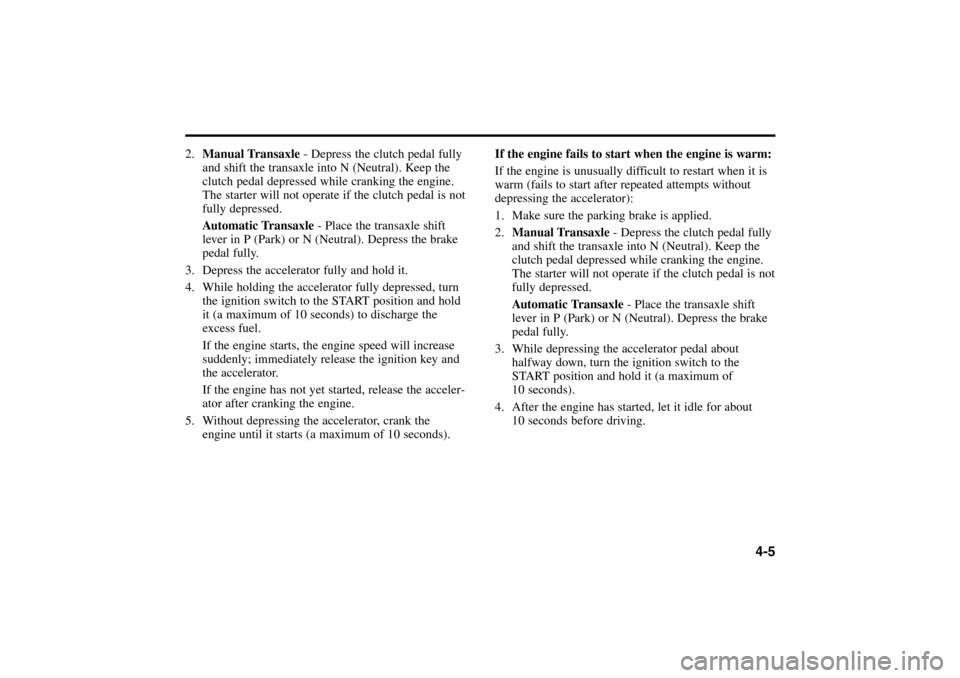
2.Manual Transaxle - Depress the clutch pedal fully
and shift the transaxle into N (Neutral). Keep the
clutch pedal depressed while cranking the engine.
The starter will not operate if the clutch pedal is not
fully depressed.
Automatic Transaxle- Place the transaxle shift
lever in P (Park) or N (Neutral). Depress the brake
pedal fully.
3. Depress the accelerator fully and hold it.
4. While holding the accelerator fully depressed, turn
the ignition switch to the START position and hold
it (a maximum of 10 seconds) to discharge the
excess fuel.
If the engine starts, the engine speed will increase
suddenly; immediately release the ignition key and
the accelerator.
If the engine has not yet started, release the acceler-
ator after cranking the engine.
5. Without depressing the accelerator, crank the
engine until it starts (a maximum of 10 seconds).If the engine fails to start when the engine is warm:
If the engine is unusually difficult to restart when it is
warm (fails to start after repeated attempts without
depressing the accelerator):
1. Make sure the parking brake is applied.
2.Manual Transaxle- Depress the clutch pedal fully
and shift the transaxle into N (Neutral). Keep the
clutch pedal depressed while cranking the engine.
The starter will not operate if the clutch pedal is not
fully depressed.
Automatic Transaxle- Place the transaxle shift
lever in P (Park) or N (Neutral). Depress the brake
pedal fully.
3. While depressing the accelerator pedal about
halfway down, turn the ignition switch to the
START position and hold it (a maximum of
10 seconds).
4. After the engine has started, let it idle for about
10 seconds before driving.
4-5
RIO ENG CNA 4.qxd 7/29/05 5:06 PM Page 5
Page 94 of 238
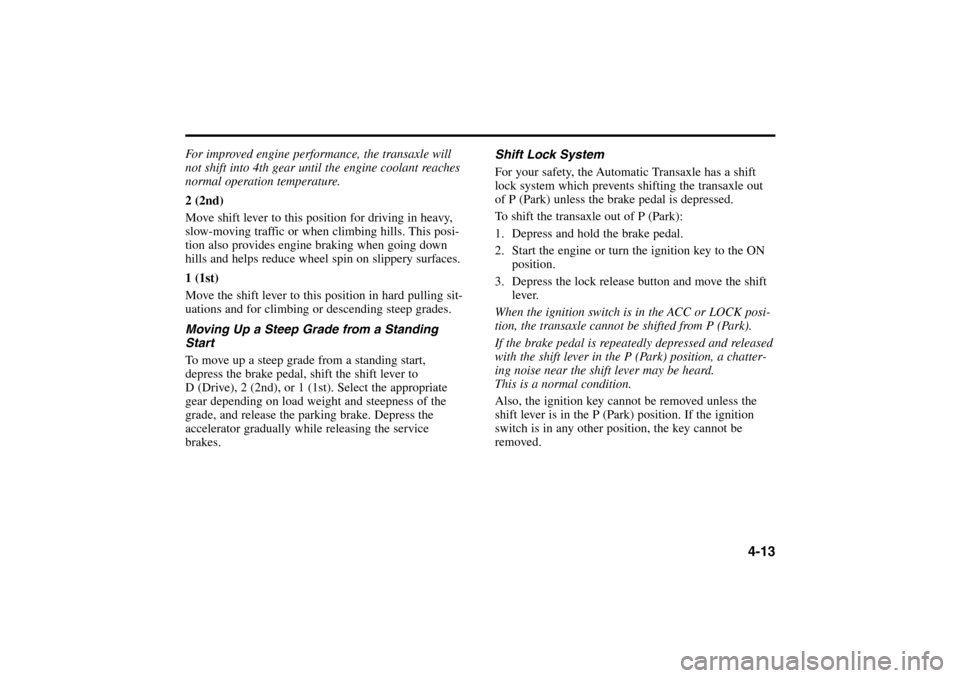
4-13
For improved engine performance, the transaxle will
not shift into 4th gear until the engine coolant reaches
normal operation temperature.
2 (2nd)
Move shift lever to this position for driving in heavy,
slow-moving traffic or when climbing hills. This posi-
tion also provides engine braking when going down
hills and helps reduce wheel spin on slippery surfaces.
1 (1st)
Move the shift lever to this position in hard pulling sit-
uations and for climbing or descending steep grades.
Moving Up a Steep Grade from a Standing
Start
To move up a steep grade from a standing start,
depress the brake pedal, shift the shift lever to
D (Drive), 2 (2nd), or 1 (1st). Select the appropriate
gear depending on load weight and steepness of the
grade, and release the parking brake. Depress the
accelerator gradually while releasing the service
brakes.Shift Lock System
For your safety, the Automatic Transaxle has a shift
lock system which prevents shifting the transaxle out
of P (Park) unless the brake pedal is depressed.
To shift the transaxle out of P (Park):
1. Depress and hold the brake pedal.
2. Start the engine or turn the ignition key to the ON
position.
3. Depress the lock release button and move the shift
lever.
When the ignition switch is in the ACC or LOCK posi-
tion, the transaxle cannot be shifted from P (Park).
If the brake pedal is repeatedly depressed and released
with the shift lever in the P (Park) position, a chatter-
ing noise near the shift lever may be heard.
This is a normal condition.
Also, the ignition key cannot be removed unless the
shift lever is in the P (Park) position. If the ignition
switch is in any other position, the key cannot be
removed.
RIO ENG CNA 4.qxd 7/29/05 5:06 PM Page 13
Page 109 of 238
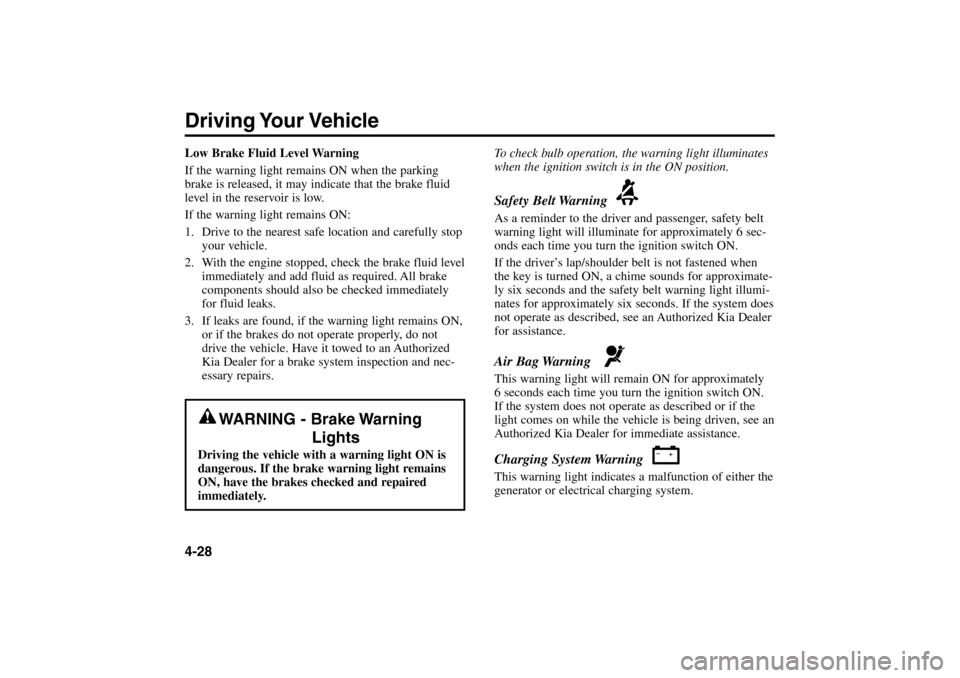
Driving Your Vehicle4-28Low Brake Fluid Level Warning
If the warning light remains ON when the parking
brake is released, it may indicate that the brake fluid
level in the reservoir is low.
If the warning light remains ON:
1. Drive to the nearest safe location and carefully stop
your vehicle.
2. With the engine stopped, check the brake fluid level
immediately and add fluid as required. All brake
components should also be checked immediately
for fluid leaks.
3. If leaks are found, if the warning light remains ON,
or if the brakes do not operate properly, do not
drive the vehicle. Have it towed to an Authorized
Kia Dealer for a brake system inspection and nec-
essary repairs.To check bulb operation, the warning light illuminates
when the ignition switch is in the ON position.
Safety Belt Warning As a reminder to the driver and passenger, safety belt
warning light will illuminate for approximately 6 sec-
onds each time you turn the ignition switch ON.
If the driver’s lap/shoulder belt is not fastened when
the key is turned ON, a chime sounds for approximate-
ly six seconds and the safety belt warning light illumi-
nates for approximately six seconds. If the system does
not operate as described, see an Authorized Kia Dealer
for assistance.Air Bag Warning This warning light will remain ON for approximately
6 seconds each time you turn the ignition switch ON.
If the system does not operate as described or if the
light comes on while the vehicle is being driven, see an
Authorized Kia Dealer for immediate assistance.Charging System Warning This warning light indicates a malfunction of either the
generator or electrical charging system.
–
+
WARNING - Brake Warning
Lights
Driving the vehicle with a warning light ON is
dangerous. If the brake warning light remains
ON, have the brakes checked and repaired
immediately.
RIO ENG CNA 4.qxd 7/29/05 5:06 PM Page 28
Page 113 of 238

Driving Your Vehicle4-32Key Reminder Warning Chime
If the driver’s door is opened and the ignition key is
left in the ignition switch, the key reminder warning
chime will sound. This is to remind you to remove
your keys from the ignition before you lock the vehi-
cle.Lights-On Warning ChimeThe lights-on warning chime will sound if the head-
light switch is left in the 1st or 2nd position and the
door is opened.Headlight High Beam Indicator This indicator illuminates when the headlights are on
and in the high beam position or when the turn signal
lever is pulled into the Flash-to-Pass position.O/D OFF Indicator
(automatic transaxle)This indicator comes on when the O/D system is
deactivated.
✽
NOTICE
A loose fuel filler cap may cause the On Board
DiagnosticSystem Malfunction Indicator Light
( ) in the instrument panel to illuminate
unnecessarily. Always make sure that the fuel
filler cap is tight.
CHECK
CHECK
RIO ENG CNA 4.qxd 7/29/05 5:06 PM Page 32
Page 114 of 238

4-33 Door Ajar Warning
This warning light comes on when a door is not closed
securely with the ignition switch in any position.Anti-Lock Brake System (ABS)
Warning Light (if equipped)This light illuminates when you start the engine. The
light will go off if the ABS system is operating nor-
mally. Also, this light comes on if the key is turned to
ON, and then goes off in 2-3 seconds if the system is
operating normally.
If this warning light illuminates while the vehicle is
being driven, have the vehicle checked by an autho-
rized Kia Dealer as soon as possible.Rear Window Defroster Indicator This light comes on when the rear defroster is ON.Rear Hatch Warning Light
(5 door-if equipped)This warning light comes on when a rear hatch is not
closed securely with the ignition switch in any posi-
tion.
AS2B04020
LightingLighting ControlTo turn the lights on, twist the knob on the end of the
control lever which is located on the steering column
to the left of the steering wheel.
First position
Tail, parking, license and sidemarker lights and instru-
ment panel lights ON.
Second position
Head, tail, parking, license and sidemarker lights and
instrument panel lights ON.
ABS
RIO ENG CNA 4.qxd 7/29/05 5:06 PM Page 33
Page 128 of 238
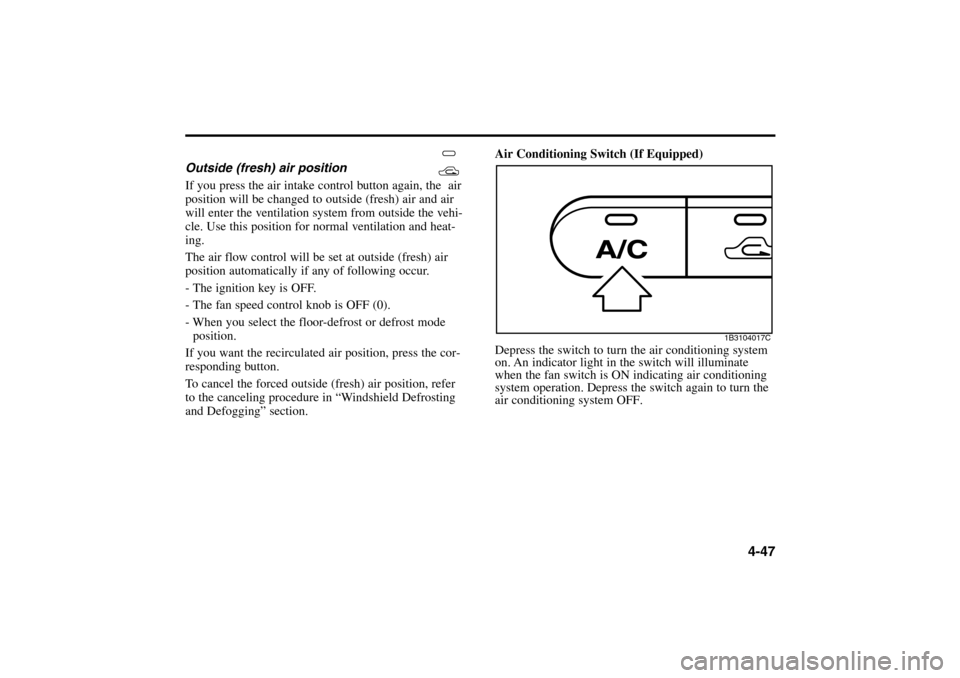
Outside (fresh) air position
If you press the air intake control button again, the air
position will be changed to outside (fresh) air and air
will enter the ventilation system from outside the vehi-
cle. Use this position for normal ventilation and heat-
ing.
The air flow control will be set at outside (fresh) air
position automatically if any of following occur.
- The ignition key is OFF.
- The fan speed control knob is OFF (0).
- When you select the floor-defrost or defrost mode
position.
If you want the recirculated air position, press the cor-
responding button.
To cancel the forced outside (fresh) air position, refer
to the canceling procedure in “Windshield Defrosting
and Defogging” section.
Air Conditioning Switch (If Equipped)
Depress the switch to turn the air conditioning system
on. An indicator light in the switch will illuminate
when the fan switch is ON indicating air conditioning
system operation. Depress the switch again to turn the
air conditioning system OFF.
4-47
1B3104017C
RIO ENG CNA 4.qxd 7/29/05 5:06 PM Page 47